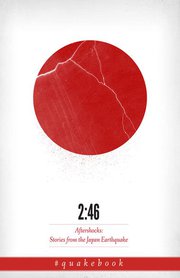Quakebook.org, eds. 2:46: Aftershocks: Stores from the Japan Earthquake (午後2時46分すべてが変わった) (Goken, 2011).
 2:46 Aftershocks is a Twitter-sourced anthology of written accounts, artwork and photographs that seeks to provide charitable support to victims of the Tōhoku disasters of March 11, 2011, and to capture the immediate intensity of emotion that emerged as a result. To that effect, editor @OurManInAbiko emphasizes the importance of timing to the creation of the book. He recounts, “one week on from the disaster (March 18th) seemed the perfect time to start gathering personal impressions: the memories were still fresh, and the aftershocks were continuing hourly, so the fear was still there.” And so, technology is vital in achieving this immediacy, for it is only with the connectivity and speed that mediums such as Twitter afford that this anthology is possible. It also allows for the creation of a community, rallied together on Twitter with the hashtag #quakebook (http://quakebook.org), that is geographically dispersed—many of the 87 written accounts contained in the book come from outside of Japan—and the bilingual edition used for this annotation provides further testament to the depth and diversity of this community.
2:46 Aftershocks is a Twitter-sourced anthology of written accounts, artwork and photographs that seeks to provide charitable support to victims of the Tōhoku disasters of March 11, 2011, and to capture the immediate intensity of emotion that emerged as a result. To that effect, editor @OurManInAbiko emphasizes the importance of timing to the creation of the book. He recounts, “one week on from the disaster (March 18th) seemed the perfect time to start gathering personal impressions: the memories were still fresh, and the aftershocks were continuing hourly, so the fear was still there.” And so, technology is vital in achieving this immediacy, for it is only with the connectivity and speed that mediums such as Twitter afford that this anthology is possible. It also allows for the creation of a community, rallied together on Twitter with the hashtag #quakebook (http://quakebook.org), that is geographically dispersed—many of the 87 written accounts contained in the book come from outside of Japan—and the bilingual edition used for this annotation provides further testament to the depth and diversity of this community.
The significance of technology in the producing this anthology makes it an innovative text, and innovation is often borne of necessity; this is certainly the case here. The necessity here is to present an account distinct from that depicted by conventional news media, which—as miscellaneously reported in the book—have a tendency to sensationalize reports. An example cited by @OurManInAbiko is the way these news agencies “focused almost exclusively on the nuclear disaster,” which though important, “was secondary when your house was in danger of collapse or you see the tsunami devastating whole regions.” Thus revealed is the inherent disjunction between experience of the disaster first-hand, and the intentions—whether these be well-meaning or laden with agenda—of we who observe from the periphery. William Gibson encapsulates these feelings eloquently as he writes: “And since then I have tried to fill an infinite depth, of moment, of field, with details I am unwilling to trust.” (page 153) And attempting to fill is perhaps the only real recourse. But even this is complicated by the capriciousness of words and language, and is something that Barry Eisler contemplates in his foreword: “The real connection is always too deep, too elusive, too mysterious ever to be corralled by language. The words will never get it right.” Despite this, he adds, “if you’re in love and you’re a writer, you have to try.” (page 12) I think it would be fair to say that this book is one such attempt.
The book considers the aftershocks that spread throughout all the accounts not only in a denotative sense (i.e. physical reverberations), but also connotatively: how we respond to disaster as a larger community (including those of us not immediately affected), taking into account the current state of technology. Hence, the Tohoku disaster is an epoch defining moment in more ways than one, and @OurManInAbiko hopes that the book can become “not only a blueprint for how communities can respond artistically to disaster, but [also] as proof that the professional journalist as gatekeeper to truth, writing the first draft of history[,] is a thing of the past.” As Michael Gakuran puts it in “Conversation”, “[s]ometimes what starts as a conversation between a few people about a shocking event can flourish into a service truly useful to many.” (page 41) And so this is the spirit of the project; it is a shared resource, containing experiences and sentiment that are not confined to the borders of page or territory.
Zachary Tan, English major, Nanyang Technological University
![[Teach311 + COVID-19] Collective](https://blogs.ntu.edu.sg/teach311/files/2020/04/Banner.jpg)